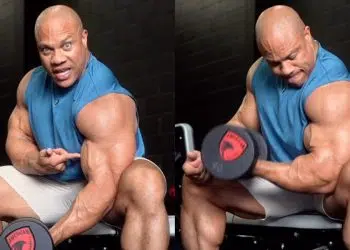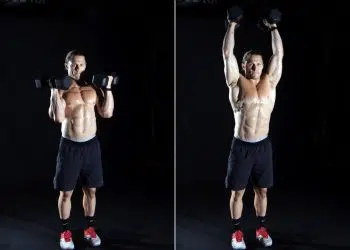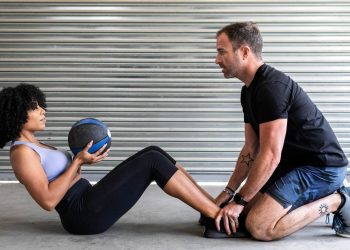While pressing movements are the bread and butter for building big, powerful shoulders, your deltoids workouts aren’t complete until you’ve included some isolation-based exercises like the dumbbell lateral raise (DLR) and its variations. Make no mistake, it’s not a “sculpting” exercise as many believe because muscles aren’t clay but you can emphasize the outer head fibers with specialized movements contributing to the highly sought after rounded delts appearance.
A versatile movement, you can train them light or heavy and some of the variations that we included in this guide are better than the dumbbell lateral raise in some ways.
In This Exercise:
- Target Muscle Group: Deltoid lateral
- Type: Hypertrophy
- Mechanics: Isolation
- Equipment: Dumbbell/s
- Difficulty: Beginner
How To Do Dumbbell Lateral Raises
Half of people do this exercise wrong because they were given the common bad advice to “pour water from a pitcher” not knowing it’s a recipe for eventual shoulders issues. In this section, we’ll set you up for success with the safe an effective way to perform dumbbell lateral raises.
Below we’ve included step-by-step instructions for proper DLR technique.
Step 1: Pick your weights
Unless you’re experienced with lateral raises, we recommend starting out with light to light-moderate dumbbells. Many times, we feel embarrassed picking up light weights but when you do things right from the start you avoid the potential for issues later on.
These are our weight recommendations for beginners just starting out. Of course, everyone is different but this is a good range for most. You also want to do a couple of progressive warm up sets starting with the lightest weights.
Level Up Your Fitness: Join our 💪 strong community in Fitness Volt Newsletter. Get daily inspiration, expert-backed workouts, nutrition tips, the latest in strength sports, and the support you need to reach your goals. Subscribe for free!
- Men: 5-15 pound dumbbells
- Women: 3-10 pound dumbbells
Step 2: Stance and dumbbell position
When setting up for DLBs you want to get in an athletic stance by leaning your torso slightly forward at the hips, bending slightly at the knees, and holding the dumbbells together in front of your thighs. That way you’ll better maintain your balance while also allowing gravity to maximize tension on the side deltoids from the slight lean forward.
Step 3: Lateral raise execution
To execute the lift, maintain a slight bend in the elbows then lift the dumbbells up and slightly back to effectively hit the fibers in the medial head. Keep the hands higher than the elbows and stop when the dumbbells the same height as your head. Slowly lower the weights back down and repeat for the desired number of repetitions.
Common Mistakes
We’re confident that you should be avoiding these common lateral raise mistakes.
Pouring water from a pitcher
We’ve all heard at one point, “pretend you’re pouring watcher from a pitcher”. This couldn’t be further from how you should really be performing dumbbell lateral raises. Rotating your wrists forward in a thumbs down position internally rotated the shoulders and doing this over and over can cause impingement issues that you’d rather avoid. The scary part is that it often takes a while for it to become a problem.
Instead, always make sure that your thumbs are higher than your pinky fingers or keep the dumbbells perfectly horizontal. This will also allow the deltoids to move freely within the ball and socket joint.
Too much weight
Believe it or not dumbbell lateral raises are no exception to ego lifting. We tend to not be as strong when lifting weights in this manner and as a result, you’ll see all kinds of funky techniques in an effort to lift the weight. Don’t be ashamed to grab the lighter dumbbells and focus on training the deltoid muscles instead of your whole body.
Not controlling negatives
According to research the eccentric or negative phase of an exercise may be just as important as the lift. Think about it, your muscles are loaded while being stretched and that probably activates additional muscle stimulus. It’s also healthier likely for the joints to not drop the weight down and jerk on the shoulders.
Dumbbell Lateral Raise Benefits
Lateral raise variations are a must if you’re looking to maximize your shoulder gains. Here are the benefits of doing them.
Rounder deltoid muscles
Overhead shoulder presses do work the lateral head of the deltoids but if you want to maximize the growth potential of a muscle then you need to be including specific exercises that replicate its primary function. Anatomically, the lateral deltoids help to raise the arms up sideways away from the body. Hence why side raises are usually always programmed in shoulder workouts.
The outer fibers are what give the rounded cannonball delts look when the body is viewed from the front.
Perfect standalone exercise
Push heavy workout routines especially focusing on chest training can overdevelop the front deltoids and as a result, many choose to skip out on overhead presses altogether. Then you have the rear delts that get a lot of attention from pulls and deadlift type exercises so where do the side delts come in? Lateral raises fill the gap perfectly and many feel theirs are underdeveloped anyway.
Drawbacks
There’s not much bad about dumbbell lateral raises. But here are some potential negatives.
Commonly misused variation
Again, the most important thing is protecting the shoulders. Many train according to bad advice and while it may not affect them right now or even a year from now, there’s a good chance it could later on down the road. An ounce of prevention is worth a pound of cure.
Poor technique
From clanking the dumbbells together at the bottom to swinging the weights up wildly with little control, not only are you taking tension off the muscles, but this will cause muscle asymmetries, and you’ll probably be complaining about joint pain. Some exercises you can perform at a more rapid pace such as machine variations but we don’t recommend it with dumbbell lateral raises.
Level Up Your Fitness: Join our 💪 strong community in Fitness Volt Newsletter. Get daily inspiration, expert-backed workouts, nutrition tips, the latest in strength sports, and the support you need to reach your goals. Subscribe for free!
Decrease the weight, slow the movement down and focus on mind-muscle connection and you’ll be happier with your effort and in less pain.
Variations and Alternatives
Dumbbell side raises are a classic delts building exercise, however, these variations and alternatives have their own advantages.
1. Seated lateral raises
Eliminate your legs from the equation by doing lateral raises seated rather than standing. Some people prefer this variation because it feels better to them, although there may not be many other advantages.
2. Single arm dumbbell lateral raises
You’ll always benefit from doing single limb exercises. These include being able to focus your attention on one muscle instead of two, correcting muscle imbalances when one side is stronger than the other, being more efficient during cheat reps, and activating additional performance-related physiological functions.
3. Cable lateral raises
Cables are a uniquely superior variation because you get the constant tension of a machine exercise and the freedom of movement that dumbbells allow.
Sizzling Cable Lateral Raise Alternatives for Wider, Sculpted Shoulders
4. Machine lateral raises
For more emphasis on pure strength and isolation, we recommend incorporating machine variations that completely lock your arms in place forcing you to adapt to the fixed path of the machine arms. This should help you to slow things down a little and have more control over the movement.
5. Resistance band lateral raises
Whether you train at home, travel a lot or need a cheaper alternative to dumbbells, resistance bands are the way to go. They do essentially the same thing but won’t break your bank as there are many affordable multi-band kits that allow you to add more resistance by simply attaching another band. If you want them to replace cables, well, they’re excellent for that too.
6. Landmine lateral raises
Make your core muscles work while you train the lateral delts by using a landmine setup.
7. 1.5 rep lateral raise
Performing lateral raises using the 1.5 rep technique is one way to kick your delts into high gear. During the half rep portion, you’re using all delt and this also requires a greater mental effort.
To do it:
- Perform just the lift portion of a lateral raise, lower your arms only halfway and raise them back up. Lower the dumbbells all the way down near your sides and repeat that sequence for the desired number of repetitions.
8. Dumbbell leaning lateral raise
By grabbing onto an object like a power rack and leaning away from it, you’ll ensure the tension remains on the deltoids as it limits range of motion in the top and bottom of each rep.
How To Program Dumbbell Lateral Raises
Dumbbell lateral raises are a versatile exercise because they make for a great warm up before presses, a good standalone shoulder builder, and the perfect finisher to end your training sessions. It just depends on how you’d like to structure your regime on any given day or week.
We do recommend incorporating lateral raises (regardless of the variation) in your workouts at least twice per week to ensure they receive enough stimulation.
Sets and reps
Lateral raises should be performed in a moderate to higher rep range as they are not a strength based movement. To do them correctly is much more challenging because you’re in a naturally weaker position to overcome an external force.
Here are our sets and reps recommendation for dumbbell lateral raises.
- Strength and hypertrophy: 2-4 sets x 7-25 reps
Muscles Involved
Lateral raises are used for one reason only, to target the outer shoulder head to create extra width, shape, and roundness.
- Deltoid lateral – The deltoid lateral is located on the outer portion of the shoulder muscle and it’s primarily responsible for abducting the arm from 15 to 100 degrees. It also helps to prevent displacement of the glenohumeral joint when the arm is pressed up against the body and under load. When well developed, the lateral deltoids contribute to roundness of the shoulders and upper body width.
- Deltoids anterior – While the front deltoids are not the focus, lateral raises still activate them. The deltoid anterior or front deltoids is one of the three heads that make up the shoulder muscles. This muscle is involved in arm flexion, stabilizing the arm while the deltoid lateral abducts the arms (raise the arm away from the midline of the body). It also works with the pectoralis major to flex the arm when walking.
- Trapezius Lower Fibers – The trapezius muscles are activated during lateral raises and there’s no way to take them out of the movement as many might think. Lower fibers are part of the trapezius muscle located on the upper back. It depresses the scapula and aids the upper fibers in upward rotation of the scapula. [3] Nice traps give a complete look to the physique when everything else is well developed.
- Trapezius Middle and Upper Fibers – The middle fibers of the trapezius muscle, between the upper and lower trap fibers, adduct (retract) the scapula while the upper trap fibers elevate and upwardly rotate the scapula and also function to extend the neck. Rows and shrugs especially activate these muscles.
Bottom Line
If you care about having more impressive outer deltoids and a wider upper body then dumbbell lateral raises and its variations are non-negotiable. It’s the ability to emphasize those middle deltoid fibers that make it a superior exercise and if you combine them with the other variations included in this guide we can almost promise you’ll be blown away with the results.
Of course, you also have to make sure you’re training with enough intensity and volume to see their potential.
Interested in measuring your progress? Check out our strength standards for Cable Lateral Raise, Shoulder Press, Deadlift, and more.











